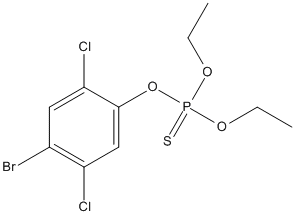Ethyl-bromophos
derivative of bromophos. See also Leptophos
General
Type : Organophosphate,Insecticide,Sulfur Compound
Chemical_Nomenclature : (4-bromo-2,5-dichlorophenoxy)-diethoxy-sulfanylidene-l5-phosphane
Canonical SMILES : CCOP(=S)(OCC)OC1=CC(=C(C=C1Cl)Br)Cl
InChI : InChI=1S\/C10H12BrCl2O3PS\/c1-3-14-17(18,15-4-2)16-10-6-8(12)7(11)5-9(10)13\/h5-6H,3-4H2,1-2H3
InChIKey : KWGUFOITWDSNQY-UHFFFAOYSA-N
Other name(s) : Nexagan,Bromofos-ethyl,Nexagan G,Filariol 60,Filariol,BROMOPHOS-ETHYL,Caswell No. 114D,Cela S 2225,Enkt 27258
MW : 394.05
Formula : C10H12BrCl2O3PS
CAS_number : 4824-78-6
PubChem : 20965
UniChem : KWGUFOITWDSNQY-UHFFFAOYSA-N
IUPHAR :
Wikipedia :

Target
References (3)
| Title : In vitro sequestration of two organophosphorus homologs by the rat liver - Santhoshkumar_1999_Chem.Biol.Interact_119-120_277 |
| Author(s) : Santhoshkumar P , Shivanandappa T |
| Ref : Chemico-Biological Interactions , 119-120 :277 , 1999 |
| Abstract : Santhoshkumar_1999_Chem.Biol.Interact_119-120_277 |
| ESTHER : Santhoshkumar_1999_Chem.Biol.Interact_119-120_277 |
| PubMedSearch : Santhoshkumar_1999_Chem.Biol.Interact_119-120_277 |
| PubMedID: 10421462 |
| Title : Laval implant sutdies with Lucilia cuprina - Shanahan_1978_Vet.Rec_103_582 |
| Author(s) : Shanahan GJ , Hughes PB |
| Ref : Vet Rec , 103 :582 , 1978 |
| Abstract : Shanahan_1978_Vet.Rec_103_582 |
| ESTHER : Shanahan_1978_Vet.Rec_103_582 |
| PubMedSearch : Shanahan_1978_Vet.Rec_103_582 |
| PubMedID: 318562 |
| Title : Detection of O,O-diethyl-O-(2,5-dichlorophenyl) phosphorothioate and O,O-diethyl-O-(3,6-dichloro-2-pyridyl) phosphorothioate in meat fat - Luke_1976_J.Assoc.Off.Anal.Chem_59_1081 |
| Author(s) : Luke BG , Dahl CJ |
| Ref : J Assoc Off Analytical Chemistry , 59 :1081 , 1976 |
| Abstract : Luke_1976_J.Assoc.Off.Anal.Chem_59_1081 |
| ESTHER : Luke_1976_J.Assoc.Off.Anal.Chem_59_1081 |
| PubMedSearch : Luke_1976_J.Assoc.Off.Anal.Chem_59_1081 |
| PubMedID: 61199 |